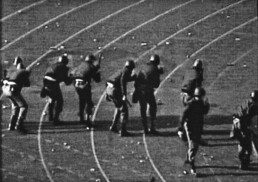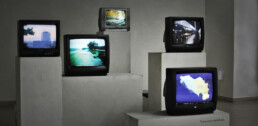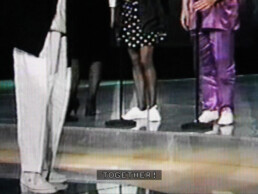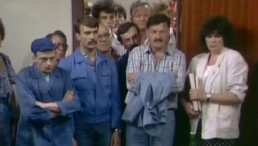Doppelgänger
Unnamed Fragments #1, 2012
Single-channel video projection
6′ 50”
Edition: 2/5
Unnamed Fragments #2, 2014
Single-channel video projection
6’10”
Edition: 1/5
Unnamed Fragments #3, 2015
Single-channel video projection
6’20”
Edition: 2/5
Unnamed Fragments #4, 2015
Five-channel video-audio installation
3’29”│4’20”│4’59”│1’36”│11’38”
Edition: 1/3
Unnamed Fragments #6, 2021
Single-channel video-projection
6′
Edition: 1/5
“The Unnamed fragments” series by the Doppelgänger art duo represents a set of artworks created since 2011 within the eponymous research project. This series of media fragments in different formats references the “unforgettable” of collective and individual memory of the final decades of Yugoslav history, mostly constructed through TV images. The Unnamed fragments project tackles the politics of media images that contributed to the construction of historical narratives in former Yugoslav regions from 1980 to 2000. The pieces constituting the series deal with the context of the media content, but now turn towards that which has been previously invisible and suppressed, and which has been marginalised or considered unimportant in the media mainstream. Through this series, in the present moment, Doppelgänger analyses and deconstructs the complexes of images and sounds of the past, bringing them into conflict and making them current. These images of the past simultaneously correspond to the present.
Unnamed Fragments #1, 2012
Single-channel video projection
6’ 50’’
Edition: 2/5
On 28 June, 1989, a “happening of the people” took place in Gazimestan, and we were its witnesses as it was broadcast on TV. This event, which hinted at the collapse of Yugoslavia and the bloodshed of the Yugoslav civil war, is remembered in history through the image of Slobodan Milošević and his speech. What history has left out is a counter-frame of the popular representation and an expression of the people. The official, primarily media memory and document have erased both of these signifiers.
“Unnamed fragments #1” vivisect the archive footage to hint at the invisible and deconstruct memory.
Purchase Contract: III-5-25/01.02.2023.
Inventory No: 173
Photo: a square from the video
Unnamed Fragments #2, 2014
Single-channel video projection
6’10”
Edition: 1/5
“Bolji život” was an immensely popular Yugoslav TV series produced by Television Belgrade. The series, combining elements of soap opera, comedy and drama had 82 episodes and was initially aired from 1987 to 1991. It is considered to be the most popular TV series in former Yugoslavia.
“Unnamed fragments #2” reveals the images that tell the story of rapid political and economic change in Yugoslavia during the 1980s and early 1990s.
Purchase Contract: III-5-166/1.6.2016.
Inventory No: 95
Photo: a square from the video
Unnamed Fragments #3, 2015
Single-channel video projection
6’20”
Edition: 2/5
The 1990 Eurovision Song Contest was the competition’s 35th edition, and took place in Zagreb, Yugoslavia on 5 May, 1990. The first state elections in Croatia took place in April and May of that year, and were followed by political debates around ethnic relations between Croats and Serbs in the Croatian republic. This led to the “Log Revolution”, which then escalated into the Croatian War of Independence.
“Unnamed fragments #3” situate this event within the broader European context.
Purchase Contract: III-5-25/01.02.2023.
Inventory No: 174
Photo: a square from the video
Unnamed Fragments #4, 2015
Five-channel video-audio installation
3’ 29”│4’ 20”│4’ 59”│1’ 36”│11′ 38”
Edition: 1/3
In Jean-Luc Goddard’s Les Carabiniers, the warriors returning from their conquests bring home postcards from all over the world as the spoils of war, and tell the following to their wives: “We’ve brought the wealth of the world with us”. Postcards and maps are means of learning geography and conquering the world.
Postcards from Yugoslavia and across the globe were used in Yugoslav Radio Television’s news programmes as visual cover shots for segments without footage on the ground. They would stay the same throughout both time and the changes in the audio commentary.
Purchase Contract: III-5-25/01.02.2023.
Inventory No: 175
Photo: a square from the video
Unnamed Fragments #6, 2021
Single-channel video-projection
6’
Edition: 1/5
On 13 May, 1990, Yugoslavia’s two best football clubs NK “Dinamo” and FK “Crvena zvezda” took on each other in Zagreb’s Maksimir stadium. The match was never played due to riots by football hooligans. However, the state media reported on the clashes between the police and the people for two hours, which many considered to be the start of the Yugoslav wars. Certain images of this event acquired iconic status. By intentionally avoiding the popular representations of the event, “Unnamed fragments #6” breathe new life into the media footage, in an attempt to distill its emotional capacity to represent time. Only ghosts and shadows remain – the images of police formations in action, under attack by invisible forces.
Purchase Contract: III-5-25/01.02.2023.
Inventory No: 176
Photo: a square from the video
ABOUT THE AUTHORS:
The art duo Doppelgänger, whose members are Isidora Ilić (1978, Novi Sad, Yugoslavia) and Boško Prostran (1979, Belgrade, Yugoslavia), is engaged in art, research and curatorial work, and textual production. Doppelgänger’s works scrutinise the relationship between art and politics by reexamining the regimes of moving images and the modes of their reception. With a reliance on the traditions of experimental film and video, Doppelgänger intervenes into existing media products or makes their own in the form of expanded film. Although moving images are their primary medium, their practice also involves text, spatial installations, performances, lectures and debates. Doppelganger’s works are part of public collections, and are also presented in independent and group exhibitions, as well as domestic and international film festivals. They have edited the Amateurs for Film (Belgrade, 2017) publication. They have won art scholarships and residences, film festival awards and Politika’s “Vladislav Ribnikar” Award.
www.doplgenger.org




